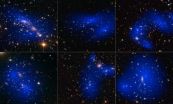(Press-News.org) HOUSTON - (March 26, 2015) - Taking out the garbage is a crucial step in housecleaning.
Similarly, autophagy is the body's first-line of defense against the buildup up of toxic substances, degrading old organelles and proteins to provide new substrates and building blocks. In this way, autophagy prevents the buildup of "garbage" that can result in destruction of neurons and cause neurologic diseases.
A forward genetic screen in Drosophila melanogaster (fruit flies) identified mutant copies, or alleles, of a gene called cacophony associated with defects in autophagy and cellular homeostasis. In a report that appears in PLOS BIOLOGY, Dr. Hugo Bellen and his colleagues at Baylor College of Medicine and the Jan and Dan Duncan Neurological Research Institute at Texas Children's Hospital and BCM, and Dr. Chao Tong, at the Life Sciences Institute and Innovation Center for Cell Biology, Zhejiang University in Hangzhou, China, find that mutations of human homologs (genes that carry out similar functions) of cacophony and its partner straightjacket (Cacna1a and Cacna2d2 respectively) cause defects in autophagy in neurons. The human homologues of these genes are associated with severe neurologic diseases such as episodic ataxia 2, familial hemiplegic migraine, absence epilepsy, progressive ataxic and spinocerebellar ataxia 6, but the molecular mechanisms by which mutations in these genes cause these diseases are poorly understood so far.
In both flies and mice, loss of autophagy-related genes leads to progressive neurodegeneration, the researchers wrote. This study found that when cacophony and its related gene straitjacket are mutated, they cause similar degenerative phenotypes in the mutant neurons as autophagy mutants. Proteins hang around, literally gumming up the works and preventing neurons from doing their job.
Voltage-gated calcium channels cannot form properly when cacophony is mutated, preventing fusion of the synaptic vesicle with the plasma membrane and neurotransmitter release.
"We were surprised to find that mutations in this gene also affect fusion of autophagic organelles," said Upasana Gala, a graduate student in the Program in Developmental Biology at BCM in Bellen's laboratory.
The authors show that the voltage gated calcium channels are present on the lysosomes that dispose of proteins. In this study, "we argue that when the acidified lysosome is depolarized by a sodium channel, it results in calcium efflux from lysosomes via the calcium channel encoded by the cacophony gene," they wrote. The calcium efflux results in higher local calcium concentration than the rest of the cell, promoting the fusion of the lysosome with endosomes.
In summary, the authors wrote, "We present a model in which calcium channels play a role in autophagy by regulating the fusion of autophagic vesicles with lysosomes and hence functions in maintaining
neuronal homeostasis."
INFORMATION:
Bellen is a Howard Hughes Medical Institute investigator and director of the Program in Developmental Biology at BCM. Tong is an assistant professor at Zhejiang University in Hangzhou, China.
Others who took part in this work include: Sonal Nagarkar Jaiswal, Alberto di Ronza, Manish Jaiswal, Shinya Yamamoto, Hector Sandoval, Lita Duraine, Marco Sardiello, Roy Sillitoe, and Chao Tong, all of BCM and the NRI at Texas Children's Hospital and BCM, Xuejun Tian, Yongping Zhang, Weina Shang, Hengyu Fan and Chao Tong, all of Life Sciences Institute and Innovation Center for Cell Biology, Zhejiang University in Hangzhou, China; Kartik Venkatachalam of the University of Texas School of Medicine at Houston and the Program in Developmental Biology at BCM.
Funding for this work came from the National Basic Research Program of China (Grant 2012CB966600), the National Natural Science Foundation of China (Grant 31271432), the Specialized Research Fund for the Doctoral Program of Higher Education (Grant 20130101110116), the Howard Hughes Medical Institute, the National Institute of Neurological Disorders and Stroke (Grant R01-NS-089664), and National Institute of General Medicine (Grant RC4-GM-096355).
While most of us recover from influenza after a week, it can be a very severe disease, and even fatal in rare cases, with no reason for physicians to have expected such an outcome. By analysing the genome of a little girl who contracted a severe form of influenza at the age of two and a half years, researchers at the Laboratory of Human Genetics of Infectious Diseases (a joint French-American international laboratory), which brings together researchers from Inserm, Paris Descartes University, and physicians from the Paris public hospitals (AP-HP; Necker Hospital for Sick ...
New research shows bacteria can use tiny magnetic particles to effectively create a 'natural battery.' According to work published in journal Science on 27 March, the bacteria can load electrons onto and discharge electrons from microscopic particles of magnetite. This discovery holds out the potential of using this mechanism to help clean up environmental pollution, and other bioengineering applications. The European Association of Geochemistry is highlighting this work as especially interesting.
According to study leader Dr James Byrne (Tübingen):
"The geochemistry ...
A study led by Cathy Spatz Widom, Distinguished Professor of Psychology at John Jay College, found that offspring of parents with histories of child abuse and neglect are themselves at risk for childhood neglect and sexual abuse but not physical abuse. Titled "Intergenerational Transmission of Child Abuse and Neglect: Real or Detection Bias?" the study's findings were reported in the March 27 issue of the journal Science.
As part of a prospective longitudinal study, Widom followed a large group of children with documented cases of childhood abuse and neglect and a demographically ...
A new study, published today in the journal PloS Neglected Tropical Diseases has given new insights into the spread of rabies in the Middle East, showing that the deadly disease regularly moves between countries in the region.
The international team of researchers including scientists from the University of Surrey and the Animal and Plant Health Agency, have mapped the spread of rabies in the region to help inform control methods.
Previous studies have demonstrated that rabies, a fatal disease transmitted by the bite or scratch from an infected animal, still kills approximately ...
Dark matter is one of science's great mysteries. It makes up an enormous amount matter in the universe, it is invisible, and it does not correspond to anything in the realm of our experience. Different theories compete for an explanation, but so far none of them has prevailed. In a collaborative study between École Polytechnique Fédérale de Lausanne (EPFL) and the University of Edinburgh, scientists have studied how dark matter behaves when galaxy clusters collide with each other over billions of years. Published in Science, their findings challenge at least ...
Foraging bats obey their own set of 'traffic rules', chasing, turning and avoiding collisions at high speed, new research from the University of Bristol, UK has found.
Dr Marc Holderied of Bristol's School of Biological Sciences studied pairs of Daubenton's bats (Myotis daubentonii) foraging low over water for stranded insects at a site near the village of Barrow Gurney in Somerset, UK.
He said: "Collective movements of flocking birds or shoaling fish are amongst the most fascinating natural phenomena, and everyone has experienced the challenges of walking through ...
CHAPEL HILL, NC - A team of researchers has discovered HIV can begin replicating in the brain as early as four months after initial infection. The study followed 72 treatment naïve participants during the first two years of HIV infection. Through analysis of cerebral spinal fluid (CSF) and blood samples, 20 percent of subjects showed replication in the central nervous system (CNS) at four months. Additionally, 30 percent of participants showed evidence of a marked CSF inflammatory response in at least one time point and 16 percent of study volunteers showed a marked ...
The fact that the neutron is slightly more massive than the proton is the reason why atomic nuclei have exactly those properties that make our world and ultimately our existence possible. Eighty years after the discovery of the neutron, a team of physicists from France, Germany, and Hungary headed by Zoltán Fodor, a researcher from Wuppertal, has finally calculated the tiny neutron-proton mass difference. The findings, which have been published in the current edition of Science, are considered a milestone by many physicists and confirm the theory of the strong interaction. ...
Astronomers using observations from the NASA/ESA Hubble Space Telescope and NASA's Chandra X-ray Observatory have studied how dark matter in clusters of galaxies behaves when the clusters collide. The results, published in the journal Science on 27 March 2015, show that dark matter interacts with itself even less than previously thought, and narrows down the options for what this mysterious substance might be.
Dark matter is a giant question mark looming over our knowledge of the Universe. There is more dark matter in the Universe than visible matter, but it is extremely ...
Say you're out shopping for basic household goods -- perhaps orange juice and soup. Or light bulbs. Or diapers for your young child. How do you choose the products you buy? Is it a complicated decision, or a simple one?
It could be complex: Factors like price, quality, and brand loyalty may run through your mind. Indeed, some scholars have developed complicated models of consumer decision-making, in which people accumulate substantial product knowledge, then weigh that knowledge against the opportunity to explore less-known products.
But in a new paper, MIT researchers ...

